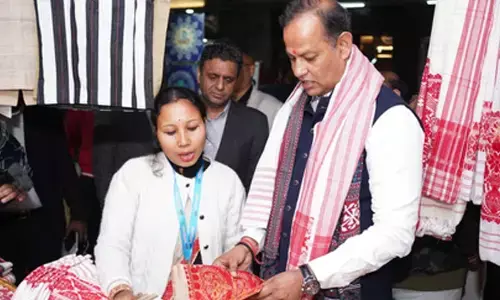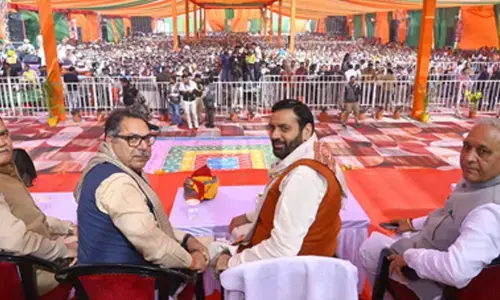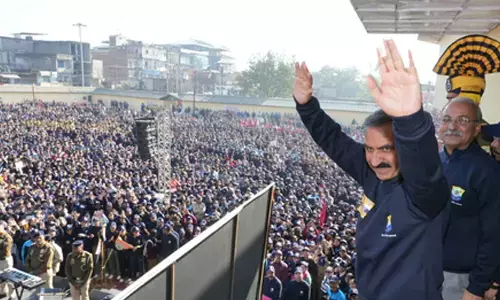Pulakesin II – Chalukya

Pulakesin II or Pulakesin-2 was one of the greatest King of Chalukya Dynasty. Pulakesin II began his rule in the year 620 A.D. Immediately after coming to the throne he restored peace in his strife-torn dynasty as well as in the country which had suffered much turmoil owing to the unrest and uncertainties.
Pulakesin II or Pulakesin-2 was one of the greatest King of Chalukya Dynasty. Pulakesin II began his rule in the year 620 A.D. Immediately after coming to the throne he restored peace in his strife-torn dynasty as well as in the country which had suffered much turmoil owing to the unrest and uncertainties.
While demonstrating his inherent strength as a King, he also granted pardon to all those who had opposed his succession. Simultaneously, he strengthened the law and order situation throughout his Kingdom.
Career and conquests
After attending to his primary duties in respect of peace and stability, he next entered upon a career of conquests and invasions. The chief aim of Pulakesin II was to convert the Chalukya Kingdom into a big southern empire.
Like the Gupta Emperor Samudragupta before him who inscribed the details of his military exploits in the famous PrayagPrasasti or Inscription, King Pulakesin II also described his military achievements in his famous AiholePrasasti or Inscription. The date of the Aihole Stone Inscription falls on 634-35 A.D.
According to the Aihole Inscriptions, Pulakesin II defeated a race named Kadambas who lived in a region called Banavasi; subjugated the Gangas of South Mysore; defeated the Moriyas of Konkana; and, humbled some other races like the Malavas, the Latas, and the Gurjaras. He also conquered the region of Pistapura and appointed his own son as the Governor of that place.
In the far south, Pulakesin II attacked the Kingdom of the Pallavas and forced King MahendraVarma I of that place to submit to his suzerainty. After subjugating the above-mentioned territories, Pulakesin II led his army across the river Kaveri and compelled the rulers of Chola, Kerala, and Pandya territories to accept his friendly diplomatic supremacy.
War with Harshavardhana
The whole of the Deccan, thus, came under the paramount authority of the Chalukya Emperor. By the time when Pulakesin II emerged as the undisputed master of the entire South, Emperor Harshavardhana was seen as the sovereign monarch of the entire North. Having established his supremacy on northern India, Harsha turned his attention towards the land beyond the Vindhyas.
With his huge army of the ‘Five-Indies’, Harshavardhan advanced for his conquest of the South. But, Pulakesin II was no less a powerful monarch to allow the northern invaders to enter into his Empire. With a large army he, therefore, faced Harsha’s army, and both the sides fought a fierce battle.
It is supposed from the descriptions of the Aihole Inscription that the battle between the opposing armies was fought somewhere between the Vindhya Mountains and the river Narmada. In that great battle, Pulakesin II successfully resisted the army of Harsha and did not permit the invaders to advance towards the south. As a result, Harsha gave up his ambition to conquer the Deccan and returned to the north.
It is thus proved that the Chalukya ruler was powerful enough to protect his southern empire from the aggressive designs of so powerful a monarch as Harshavardhan himself. It is believed that the river Narmada was recognized as the frontier line between the empires of the ‘Lord of the North’ Harsha, and the ‘Lord of the South’ Pulakesin II.
Administration
Pulakesin II was not only a powerful King from the view point of military successes, but also is regarded as one of the most benevolent administrators of the southern history. The celebrated Chinese Pilgrim Hiuen Tsang, who visited India during the reign of Harshavardhan and became intimate to that Emperor, also visited the Chalukya territory in the South when Pulakesin II ruled. That foreign observer was full of praise for Pulakesin both for his power and for his benevolence.
Foreign Relations
The power of this King was known to outside kings also. It is said that he maintained diplomatic relations with some foreign lands and even exchanged diplomatic missions with his contemporary King of Persia, Khursu II.
Last days and death
The rule of Pulakesin II, however, did not come to a peaceful end. As his reign began with battles, so also it concluded with battles. A believer in both offensive and defensive wars, he did not stop from fighting with other kings because of his lust for power and his ever aggressive character.
He invaded the same Pallava Kingdom once again. This time, however, Pulakesin’s expeditions did not succeed, and he had to return to his capital in shame. Soon thereafter, the Pallava King NarasimhaVarman invaded the Chalukya Kingdom and his soldiers surrounded its capital, Badami. In that resistance battle, Pulakesin II lost his life in 642 A.D. Thus that ended the life of a great King who loved to fight battles.
Successors of Pulakesin II
After the death of Pulakesin II, dark days descended on the Chalukya reign. His son and successor Vikramaditya I, after an initial period of political disaster, gradually became able to recover the lost glories of the Chalukyas. During his reign from 655 to 681 A.D., he conquered some territories of the Chola, Pandya and Kerala Kingdoms and merged those areas with the Chalukya Kingdom.
After Vikramaditya I, his successors were able to retain their power for some more years. But by 8th century A.D., the Deccan saw the rise of the Rashtrakutas to power. With that there ended the power of the Chalukyas in the South.
Recently, Researchers from the Bhandarkar Oriental Research Institute (BORI), which houses South Asia’s largest collection of manuscripts and rare texts, claim to have fixed the date of Emperor Harshavardhan’s defeat to the Chalukya King Pulakeshin II by decoding a copper plate. The date of Pulakeshi’s great triumph over Harsha in a battle fought primarily with elephants, on the banks of the Narmada, can now be fixed at 618 AD, as claimed by BORI.
Previously, British Indologist and historian Vincent A Smith, with astonishing accuracy, placed the date of the battle at around 620 AD. The copperplate is also useful in fixing the details of the coronation of Pulakeshi II in 610-611 AD.
Pulakeshin anointed himself king after defeating his uncle, Mangalesha. Legend has it that Mangalesha, the regent, wanted to deny his nephew the Chalukya throne. The plate further records the grant of 50 ‘nivarthanas’ (a unit of land) by Pulakeshin from the village Brahmana-Vataviya (in modern-day Paithan Taluka of Aurangabad) to a Vedic scholar, Nagasharma.
















